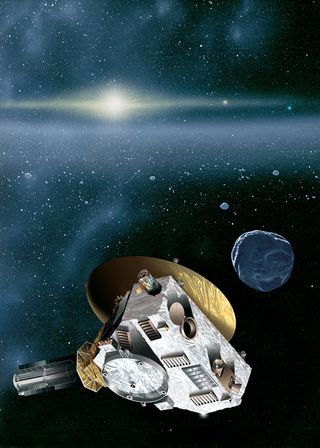
A NASA spacecraft's historic flyby of Pluto is more than a year away, but researchers are already thinking about where the probe will go next.
Scientists will use the space agency's Hubble Space Telescope to search for another faraway object that could be visited by the New Horizons probe after its Pluto encounter, which is scheduled to take place in July 2015, NASA officials announced today (June 16).
"I am pleased that our science peer-review process arrived at a consensus as to how to effectively use Hubble's unique capabilities to support the science goals of the New Horizons mission," Matt Mountain, director of the Space Telescope Science Institute (STScI) in Baltimore, which operates Hubble, said in a statement. [NASA's New Horizons Flight to Pluto in Pictures]
"The planned search for a suitable target for New Horizons further demonstrates how Hubble is effectively being used to support humankind's initial reconnaissance of the solar system," he added.
Hubble will perform a test run first, searching a small patch of sky in the constellation Sagittarius for objects in the Kuiper Belt, the ring of frigid bodies (including Pluto) that circles the sun beyond Neptune's orbit.
Spotting these small, dark bodies will be a challenge. Researchers will turn Hubble as fast as Kuiper Belt objects (KBOs) are predicted to move against the background stars. The stars will show up as streaks in the resulting images, while any KBOs will be captured as points, NASA officials said.
If Hubble finds at least two KBOs with a specified brightness, researchers will carry out a bona fide hunt for an object beyond Pluto that New Horizons could visit. This search will cover a field of view about the size of the full moon, scientists said.
Get the Space.com Newsletter
Breaking space news, the latest updates on rocket launches, skywatching events and more!

This stepwise approach was chosen because time on the powerful Hubble is so coveted and contested, with requested observing time greatly exceeding actual observing time every year. Astronomers around the world apply to use the instrument; their proposals are reviewed by an expert committee, which passes on its recommendations to the STScI director.
Hubble has already played a key supporting role in the $700 million New Horizons mission, which launched in January 2006 to give humanity its first up-close looks at the Pluto system. For example, Hubble has discovered four of Pluto's five known moons, spotting Nix and Hydra in 2005, Kerberos in 2011 and Styx in 2012. (The other satellite, Charon, was found in 1978.)
Hubble, which launched in April 1990, has also conducted a search for dust rings around the dwarf planet that could pose a danger to the fast-flying New Horizons.
Follow Mike Wall on Twitter @michaeldwall and Google+. Follow us @Spacedotcom, Facebook or Google+. Originally published on Space.com.
Join our Space Forums to keep talking space on the latest missions, night sky and more! And if you have a news tip, correction or comment, let us know at: community@space.com.

Michael Wall is a Senior Space Writer with Space.com and joined the team in 2010. He primarily covers exoplanets, spaceflight and military space, but has been known to dabble in the space art beat. His book about the search for alien life, "Out There," was published on Nov. 13, 2018. Before becoming a science writer, Michael worked as a herpetologist and wildlife biologist. He has a Ph.D. in evolutionary biology from the University of Sydney, Australia, a bachelor's degree from the University of Arizona, and a graduate certificate in science writing from the University of California, Santa Cruz. To find out what his latest project is, you can follow Michael on Twitter.
